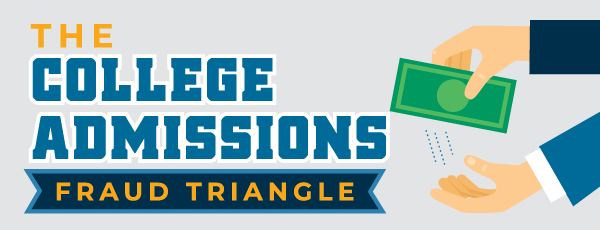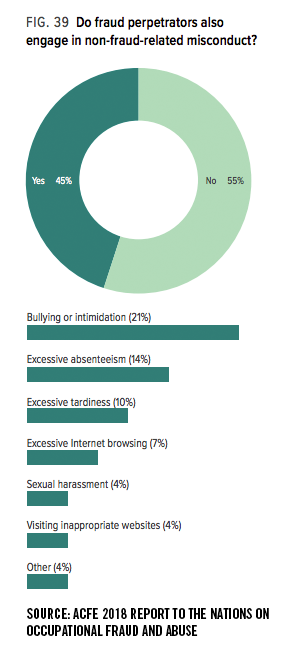The ACFE’s 5 Big Fraud Tips You Should Act on Now

As part of the 2019 International Fraud Awareness Week, the Association of Certified Fraud Examiners (ACFE) distributes information and training to help anti-fraud professionals reduce the incidence of fraud and white-collar crime. A recent ACFE publication, 5 Fraud Tips Every Business Leader Should Act On, spells out five ways organizations can work to prevent and minimize fraud in the workplace. We’ve paired their recommendations with the research-based actions you can take to achieve these aims.
1. Be Proactive
A code of ethics for management and employees sets the tone that your organization is committed to conducting business honestly and fairly. Fortify your commitment with internal controls around areas of the business that are vulnerable to fraud.
In its 2018 Report to the Nations, the ACFE studied nearly 3,000 incidents of fraud across 125 nations. Here are the top 10 most common anti-fraud controls they found among the organizations in the study:
- Code of conduct: 80%
- External audit of financial statements: 80%
- Internal audit department: 73%
- Management certification of financial statements: 72%
- External audit of internal controls over financial reporting: 67%
- Management review: 66%
- Hotline: 63%
- Independent audit committee: 61%
- Employee support programs: 54%
- Anti-fraud policy: 54%
The study found that weaknesses in internal controls were responsible for nearly 50 percent of all fraud cases.
2. Establish Hiring Procedures
Background checks will continue to be one of the best practices any workplace can implement, yet surprisingly, a full 96 percent of fraud perpetrators had no prior fraud conviction, according to the AFCE’s 2018 report. Therefore, understanding the behavioral red flags displayed by fraud perpetrators can help organizations detect fraud and mitigate losses. The AFCE found that 85 percent of fraudsters displayed at least one of the six red flags listed below and 50 percent of them exhibited multiple red flags.
Six Red Flags of Fraud:
- Living beyond means
- Financial difficulties
- An unusually close relationship with vendor/customer
- Control issues, unwillingness to share duties
- Divorce/family problems
- “Wheeler-dealer” attitude
3. Train Employees in Fraud Prevention
Looking for signs of fraud isn’t top of mind for most employees, but having a code of ethics and internal controls create a strong workplace culture that’s attuned to the possibility of fraudulent activity. Employers can take this awareness a step further by educating employees on how to recognize fraud in their day-to-day lives.
Here are the top eight concealment strategies used by fraudsters:
- Created fraudulent documents: 55%
- Altered physical documents: 48%
- Created fraudulent transactions in the accounting system: 42%
- Altered transactions in the accounting system: 34%
- Altered electronic documents or files: 31%
- Destroyed physical documents: 30%
- Created fraudulent electronic documents or files: 29%
- Created fraudulent journal entries: 27%
4. Implement a Fraud Hotline
Now that employees know some of the signs to look for, employers should also provide a clear means for reporting suspected fraud. The top three ways that fraud is detected are through tips (40%), internal audits (15%), and management review (13%).
Employees are responsible for reporting 53 percent of occupational fraud cases with the remaining coming from outside parties, such as customers, vendors, or shareholders.
Having a fraud hotline has proved to be instrumental in detecting fraud. In fact, 46 percent of cases detected by tips in the AFCE’s study had hotlines versus 30 percent coming from tips where no hotline existed.
5. Increase the Perception of Detection
Keeping the risk of fraud both top of mind and at the forefront of your organizational policies and practices is key to preventing, recognizing, and mitigating its impacts. In addition to having employees sign a code of conduct, make sure you’re regularly communicating to staff about anti-fraud policies. Remind them of the methods available to report suspicions of misconduct and the potential consequences (including termination and prosecution) of fraudulent behavior.
Though 42 percent of the organizations in the 2018 Report to the Nation offered hotlines to report fraud tips, other mechanisms are also readily available. They include:
- Email: 26%
- Webform/online: 23%
- Mailed letter: 16%
- Other: 9%
- Fax: 1%
To learn more about helping your organization combat fraud, stay tuned here for the rest of our our 2019 Fraud Week Series. If you need help formulating your fraud prevention program, request a meeting with a risk management expert at Lowers & Associates.






